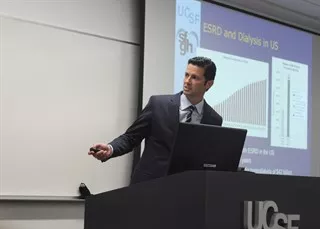Percutaneous AV Fistula
A Method for Dialysis Access
Principal Investigator: Shant Vartanian, MD
Team Members: Dillon Kwiat

Challenge
Over 2 million patients receive hemodialysis globally and the incidence of end stage renal disease (ESRD) is expected to grow over the next 20 years as diabetes and obesity--two risk factors for ESRD--have grown to epidemic proportions worldwide. Patients who initiate hemodialysis via an arteriovenous fistula (AVF) have 37% lower mortality than those dialyzed with a tunneled catheter and an 18% lower mortality rate than those dialyzed with an arteriovenous graft. AVFs also have better durability, lower rates of revision, and lower rates of infection and hospitalization, all of which translate into better outcomes for patients and cost savings for the health care system. Yet despite the clear benefits to initiating hemodialysis with an AVF, there are barriers that prevent patients from initiating dialysis with an AVF, including the need for referral to a surgical specialist and fear and anxiety of undergoing a surgical procedure.
Solution
We are developing a minimally invasive, percutaneous method, which can create an AV fistula in the clinic. The procedure can be performed under local anesthesia with ultrasound guidance. This creates an opportunity to improve delivery of care, particularly to areas of health care disparities, and has significant cost saving implicantions for health care payers by moving the procedure from the OR to the clinic.
Honors & Awards
Catalyst Award (Spring 2018)
Surgical Innovations Accelerator (Spring 2017)
Featured Media
Surgical Innovations Accelerator Projects Harness Unique Talents of MTM Student Teams - UCSF Surgical Innovations - October 5, 2017
Accelerator Awards Presented at 2nd Annual Surgical Innovations Shark Tank - UCSF Surgical Innovations - April 24, 2017
